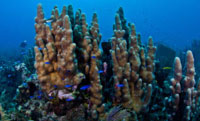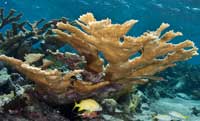Though there are several hundred species of Acropora throughout the Indo-Pacific, Elkhorn coral and Staghorn coral are the only two species described within the Caribbean. They are fast growing, branching species and major reef-building corals, contributing significantly to reef growth, island formation, coastal protection and fisheries habitat. The open structural framework of these densely populated Acropora thickets provides essential habitat for fishes, turtles, lobsters, crabs, echinoids and gastropods. Acropora corals have declined 80-90 % since the 1980s throughout the Caribbean and are listed as Critically Endangered by IUCN. Acropora corals are presumably recovering in Jardines de la Reina.
Black corals (Anthipates sp.):

There are approximately 15 species of Black corals in the Caribbean that can be found within safe SCUBA diving depths. Few species attain considerable size and their branches are collected, cut, fashioned, polished and sold by jewelers as a semiprecious material. The value of these trinkets comes more from propaganda of rareness and the danger associated with deep diving to collect branches, than from any innate property of the material. Unfortunately, these species are rare throughout their range of distribution due to overharvesting. Jardines de la Reina is one of the few places in the Caribbean where you can enjoy Black corals in almost every SCUBA dive. It is included in the Appendix II of Resolution 161/11.
Pilar coral (Dendrogyra cilindrus):

It is one of the most magnificent coral species in the Caribbean. Colonies form numerous, heavym cylindrical spires that grow upward from an encrusting base mass that name the species. Inhabit flat and slightly sloping bottoms. Polyps are normally extended during the day (most of the other corals show their polyps during night), giving colony a fuzzy appearance. Occasional to rare throughout its range of distribution, Pilar coral is frequent in Jardines de la Reina. It is included in the Appendix II of Resolution 161/11.



